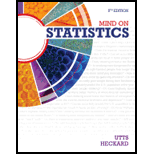
(a)
To find: Whether the given variable is discrete or continuous.
(a)
Answer to Problem 8.1E
The given variable is discrete.
Explanation of Solution
Given:
The variable is “Number of commercials that are shown”.
A variable whose value is determined by counting is referred to as a discrete variable. A continuous variable is one whose value may be determined through measurement.
In this case, the given variable, the number of commercials shown, can be counted and does not take unrounded values. Thus, it can be considered an example of a discrete random variable.
Therefore, the variable is a discrete variable.
(b)
To find: The given variable is discrete or continuous.
(b)
Answer to Problem 8.1E
The given variable is continuous.
Explanation of Solution
The given variable is the length which is noted in seconds. The variable's length can take any value within a certain
Therefore, the variable is continuous.
(c)
To find: The given variable is discrete or continuous.
(c)
Answer to Problem 8.1E
The given variable is discrete.
Explanation of Solution
In this case, the given variable is the number of accidents recorded. The variable can only have two values that can be counted and do not take unrounded values. Thus, it can be considered an example of a discrete random variable.
Therefore, the variable is discrete.
(d)
To find: The given variable is discrete or continuous.
(d)
Answer to Problem 8.1E
The given variable is discrete.
Explanation of Solution
In this case, the given variable is whether the rain is predicted. The variable can only have two values that can be counted and do not take unrounded values. Thus, it can be considered an example of a discrete random variable.
Therefore, the variable is discrete.
Want to see more full solutions like this?
Chapter 8 Solutions
Mind on Statistics
- Algebra & Trigonometry with Analytic GeometryAlgebraISBN:9781133382119Author:SwokowskiPublisher:Cengage
 Functions and Change: A Modeling Approach to Coll...AlgebraISBN:9781337111348Author:Bruce Crauder, Benny Evans, Alan NoellPublisher:Cengage Learning
Functions and Change: A Modeling Approach to Coll...AlgebraISBN:9781337111348Author:Bruce Crauder, Benny Evans, Alan NoellPublisher:Cengage Learning Algebra: Structure And Method, Book 1AlgebraISBN:9780395977224Author:Richard G. Brown, Mary P. Dolciani, Robert H. Sorgenfrey, William L. ColePublisher:McDougal Littell
Algebra: Structure And Method, Book 1AlgebraISBN:9780395977224Author:Richard G. Brown, Mary P. Dolciani, Robert H. Sorgenfrey, William L. ColePublisher:McDougal Littell


